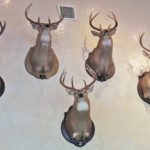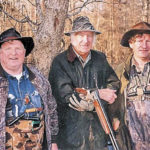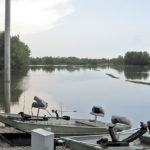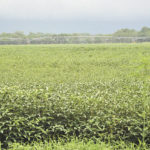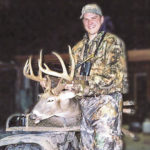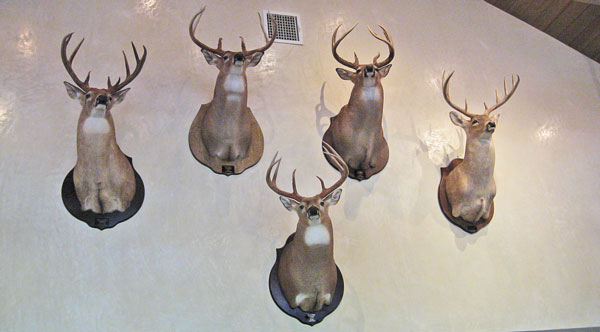
Three friends have transformed an old cow pasture into a widlife mecca in Caldwell Parish.
It was a common thread that bound Ronny Graham, Ronnie Myrick and Ken Newton together. They were college buddies who loved to hunt ducks and dreamed of having a place of their own where they could enjoy their sport. After graduating from Northeast Louisiana University, now University of Louisiana at Monroe, their dreams were fulfilled when they pooled their resources to purchase a 265-acre plot of ground in Caldwell Parish.
“This place would flood in fall and winter except for an island on the property. This island had always been called Perrin Island, so after we bought the place, we named our new property after the island,” Myrick explained. “We developed Perrin Island into a greentree reservoir, and enjoyed some great duck hunting for several years. After awhile, the topography gradually changed, and hunting success began to decline.”
In the meantime, another larger piece of property a couple of miles to the northwest of Perrin Island caught the eyes of two of the friends, Graham and Myrick. This 1,900-acre tract was an old farm that had declined in quality for farming, and after the death of the owner, became available for purchase. Graham and Myrick, along with Ronny Graham’s brother, Danny, decided to take the plunge and purchase the old farm in1995.
“To be honest, it wasn’t a very good-looking piece of land; it had a few rolling hills with lots of sloughs and gullies, was brushy and overgrown with not many desirable features to catch the eye. However,” Myrick noted, “we realized that the land was situated in a natural duck flyway with Bayou Lafourche, Boeuf River and the Ouachita River all bottlenecking no more than five miles below the property.
“Although this was a rough-cut piece of land, we saw the potential for developing it into a place attractive to waterfowl, so we purchased the property and named it The Wetlands.”
According to Danny Graham, the property had a variety of soil types, and with the proper management could be flooded and de-watered as needed, but it would take a lot of work and planning to make that happen.
“Soil types ran the gamut from heavy gumbo to good soils,” Danny Graham said. “We knew it was located in a good spot to attract waterfowl because of its location under a natural flyway. However, we knew that both food and water are necessary to attract ducks, and we knew that with lots of guidance and help, we could provide what the birds needed.
“Lots of dreaming and planning went into our plans with help from agencies such as the Natural Resources Conservation Service and their Wetlands Reserve Program and Conservation Reserve Program.
“NRCS representative Denver McKeithen was invaluable to us because he surveyed the property and helped us design the area for maximum advantage to make it attractive to waterfowl.”
Since acquiring the old farm in 1995, Myrick and the Graham brothers have purchased additional tracts contiguous to the farm as they’ve come available. The Wetlands now consists of some 3,600 acres, and according to Myrick, more adjoining lands will be purchased as they come available.
“The picture began forming in our minds that we could take what God put here, plug up one end of it and have the type water we needed to attract ducks,” Danny noted. “We had to try and figure out how to get water on and off at the right time because this is the formula for success in what we were trying to do.
Today, we can move water where and when we want it with the 50-60 structures and pumps we have installed to manage water. Ducks Unlimited helped us by showing us where to put our levees, water-control structures, etc.”
The Wetlands annually produces a harvest of 1,200 to 1,300 ducks, but hunting success usually increases later in the season when other hunting areas in Northeast Louisiana are declining.
“By the time everybody else sees their ducks vanishing from farmlands to the north, that’s when our (hunting) takes off,” said Myrick. “Once the food left from harvesting crops from the farmlands up north has been eaten up, the ducks filter on down to us because we have so much natural food growing here.
“Farmers hate barnyard grass, but we love it. It has a long head with lots of seed, and ducks prefer it because it’s high in protein. Also, when you put water over it, the quality of the seed doesn’t deteriorate like rice does after it’s been out awhile. Smart weed is another natural plant that provides food, and we let it grow on our place as well.
“Another thing we provide that helps keep ducks in the area is a 70-acre reservoir that we never hunt; it’s a place for ducks to rest and not be disturbed. In addition, we don’t over-hunt our place. The three of us have our own areas we hunt; we have three to four blinds in each area. These areas are assigned prior to season, and we know the general area where the others and their guests are hunting. Therefore, there is never the problem of crowding and putting too much pressure on the birds.
“Managing our land for waterfowl is a year-long job; we start working on next year the day after this year’s season closes. We plant, bush hog and along with the help of the farmer who we have hired who lives on the place, it’s a never-ending process.”
While ducks have gotten the most attention over the past decade and a half, the work being done on the property has improved the lot for at least two other species, deer and fish.
“When we first bought the property,” Danny Graham said, “there was a small herd of deer that hung out in the limited area where there were some trees. For the first several years, we didn’t shoot any deer down here.
“We started planting trees under the WRP program, and as the trees grew, the deer then had more cover and the herd began to grow. Then one day I had a friend down as a guest to hunt, and he shot a monster buck. We knew then that this place had the potential to produce some trophy deer, but we would have to manage them as we have the ducks.
“Since then, we’ve been doing things specific for deer. We shoot does to keep the deer numbers in check, we provide plenty of food and we don’t shoot young bucks. We have permanent food plots that we keep planted and active 12 months long. Chicory and clover are two mainstays, and these are available for deer the whole year.”
For proof of how the deer have responded to what the Grahams and Myrick have provided, all one has to do is check the lodge. Hanging on the walls are monster buck mounts taken on The Wetlands, impressive enough to make any deer hunter envious.
Not everything is perfect, though, when trying to provide a place to raise quality deer. According to Graham, predators are a big problem, and the property has become over-run with feral hogs.
“We probably shoot 100 hogs a year while we’re hunting, and there are lots of bobcats and coyotes on the place,” he said. “I recently read an article that revealed that as many as 60-70 percent of the fawns born each year on a place such as ours are killed by predators.”
All the property is jointly owned by the Graham brothers and Myrick with each having his own lodge. Soybeans are farmed on the property by the farmer hired by the owners, and income from farming helps defray costs of road maintenance and other necessary expenses.
Under the NRCS program, one of the goals is to provide both water and high ground to benefit all species of wildlife. As a result, an area was selected to construct a “serpentine” water body where the dirt removed to make the channel worked as a spoil bank that also provided high ground.
“Although that agency is not in the business of building fishing lakes, what resulted after the winding waterway was completed was yet another resource for us,” Danny Graham said. “We dug the channel out to 8 feet deep, creating a serpentine lake about 50 acres in size. We stocked it with bass — we used Florida/Northern largemouth hybrids. In addition, we stocked the lake with coppernose bluegills, and Southern Pond Management advises us on getting the most out of our lake.
“We also put some grass carp in the lake because it is fairly shallow, and we would have a big problem with an over-abundance of aquatic vegetation if we weren’t able to keep it in check.
“Because it was already in a wetland area, there were lots of amphibians — frogs and crawfish — naturally there. In addition, we add crawfish every year to give the fish plenty to eat. We are already catching bass in the 10-pound range on the lake, and the bream are good sized as well.”
As a side benefit, the area is attractive to shore birds. On a recent visit to the area, I observed a mute swan sitting on an island in the lake surrounded by egrets, herons and other such species.
“Two swans showed up here a couple of years ago, and they’re right at home here. Something happened to one of them because there’s only one now,” Graham said.
From ducks to bucks to bass, The Wetlands is living proof of what can be done with a washed-up farm if you’re willing to commit the time and resources to make it happen.
